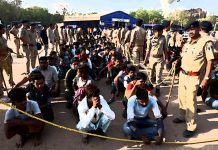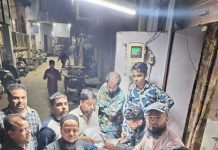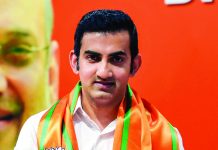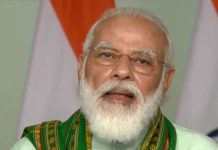
People are dying due to an irregular supply of oxygen to keep them alive and breathing. Ironically, this tragedy is taking place today, in this day and age and in these developed times
As I have been writing, battling the virus or a horde of viruses is just one aspect. The other is, perhaps, more vital, and that is poor or zero governance! Where is that basic oxygen supply to the hundreds of patients! An interrupted to nil supply of oxygen is killing the patients!
This is the harsh and stark reality of the times we live in. Where our people, our fellow citizens are dying because there is no regular supply of oxygen to keep them alive and breathing! Mind you, this tragedy is taking place today, in this day and age, in these developed times!
How would one describe these deaths of the patients left gasping, collapsing and dying? How would one describe the failed system? How would one describe the political rot that’s set in? How would one remain patient and calm seeing so many deaths, taking place inside and outside the hospitals? Mind you, all these deaths could have been prevented if only we had focused on our people and their life and well- being, and not on the elections and election rallies and the hollow speeches heaped on the naïve masses by the ruthless rulers of the day!
Signs of fascism!
Signs of fascism are spreading out, yet as mute spectators we sit all too quiet and subdued. In fact, one of the prominent signs is exactly this. That is, the masses will be rendered so fragile and helpless that they wouldn’t be able to combat the disasters and tyrannies heaped on them by the political rulers.
Another significant sign is the attack on books and libraries and the written word. News reports of the proposed or upcoming demolition of one particular segment or section of the internationally known Patna situated library, the Khuda Bakhsh Library, came as a shocker. Talk to any scholar and he and she will detail how this heritage library is simply loaded with treasure, in the form and shape of rare manuscripts and volumes.
In fact, last evening as I got in touch with the Varanasi-based historian, Dr Mohammad Arif, who taught history at Banaras Hindu University (BHU) and is the Chairman of the Centre Harmony and Peace. He told me that he spent years at the Khuda Bakhsh Library when he was doing his doctorate on the Tughlaq dynasty.
To quote this historian, “During my research years and also during the post-doctorate phase, I spent months or years at this library. It has rare books in Urdu, Arabic, Persian …those musts for any scholar delving into our Medieval History. It’s one of those libraries that ought to be nurtured and kept safe if we have to keep our heritage all intact. Also, let’s not bypass this touching factor: This massive world famous library was started by Khuda Bakhsh with only 1,400 books which his father, Maulvi Mohammad Bakhsh, had gifted him. It’s with tremendous hard work and sheer focus that Khuda Bakhsh could collect thousands of books…build this collection. ”
In fact, this historian also told me that just few years back another library was demolished. The Karl Michael Library in Varanasi. “The Karl Michael library was setup by a British collector in the Raj days but it was demolished when the Kashi Vishwanath Corridor was coming up…A setback for the scholars and students of this city but one couldn’t do a thing but lament…there’s a worry, the way things are going on, we could be ending up sans rare manuscripts and books and libraries which form the very base of any civilization…our heritage seems in danger!”
♦ ♦ ♦
Another shocker awaited. Last fortnight a Muslim labourer’s library housing 11, 000 books were burnt in Karnataka’s Mysuru … 62-year-old Syed Isaaq is a daily wager who couldn’t attend school because of his family’s financial condition and constrains and to make up for that loss he started collecting books and more books… hundreds of books in Kannada, English, Urdu. In fact, his library also had copies of the Bible, Quran, Bhagwat Gita. And for the last 10 years, his library was open to all, free of cost.
Now with all his books reduced to ashes, the only ray of hope is that Syed Isaaq’s spirit hasn’t been hit. He plans to re-build his library. My Salaams to his spirit! I do wish and hope the people of Mysuru would help him re-build his library. Let writers and authors and publishers help him re-build his library.
Don’t know whether the goons who burnt this library would ever be caught or like ‘unknown killers of the day’ go about scot free! After all, actual killers and destroyers are rarely apprehended in today’s fascist times.
SATYAJIT RAY”s UPCOMING BIRTH ANNIVERSARY…
As Satyajit Ray’s hundredth birth anniversary nears, it’s rather unfortunate that there’s been little focus on his personal life. This film maker was born on 2 May 1921 and had passed away on 23 April 1992, in Kolkata. He was a genius, mastering the various arts, a director of international repute and then, to top it all, he had those handsome looks, that rich booming voice, that classy sophistication that rather too automatically kept him apart, much above from the rest of his tribe.
Then, why is it that there haven’t been any detailed write-ups about his personal life? This could be because his name was never really linked with any woman he’d worked with.Most knew that he was a happily married man. Bijoya was not just his wife but also his first cousin (maternal uncle’s daughter ) and they’d been very close, more like companions or best friends right from childhood. Satyajit was barely two years old when his father died. So his mother had decided to live with her brother’s family… And Bijoya and he clicked, for she was artistic, interested in music and films.
In fact, she herself had a brief spell in Hindi films in Bombay but had quit acting after marriage and kept helping him all through. Bijoya, in fact, discovered Subir Banerjee for the role of Apu, literally the boy next door. A few know that she had even pawned her jewellery to help her husband complete his first film.
In fact, in Satyajit Ray’s own words, in his biography (Marie Seton), he talks of Bijoya: “She always is the first person to read my script. Her comments are often pertinent and sometimes ruthless. She always has very instinctive reactions, feminine reactions to certain things, which I find very useful. And I almost always incorporate.”
What did Bijoya have to say about her husband Satyajit Ray (from Andrew Robinson’s biography), “What I admire about Manik (as Ray was called) is his simplicity, his honesty, his generosity, his kindness and above all his ability to mix with people from all walks? He is at home with everybody. This is the hallmark of all great men.”
And another biography on Ray – titled: The World of Satyajit Ray, written by the veteran journalist Bidyut Sarkar, also dwells on his association with Ray. To quote him — “In 1958, when I was in New York, I got the news that Ray was planning to visit New York on the occasion of the general release of Pather Panchali.
I wrote to him, inviting him to stay with me. I could feel that a man of domestic habits would not be comfortable in the impersonal hotels, and he wrote back accepting my offer. Whilst he was there I’d see him sitting and looking at the gorgeous view of Central Park facing his room and the apartment, but it seemed as though the Park seemed to magically vanish from his horizon when he would look out and conjure up in sketches the sequences and striking settings of his next film set in Bengal.”
On why Bidyut Sarkar decided to do this biography on Ray he had told me, “I had been keeping notes on Ray for years but the idea to write this book came up much later. In fact, I got the inspiration when Ray told his biographer Andrew Robinson to learn Bengali. That struck me since I had the advantage of knowing Bengali.”
Sarkar had also detailed the lesser-known aspects to Ray, “Only two women appeared to have influenced him – his mother and his wife. His mother, a remarkable woman who was widowed early in life, played a key role in Ray’s growth. Bijoya, his wife, took over the role so far as Ray’s artistic development was concerned.”
Even in his leading actresses, Ray never looked for dolled-up glamour but for the intelligent beauty. Madhabi Mukherjee, Sharmila Tagore, and in his last three films, Mamata Shankar, best fitted that description.
In fact, Ray’s biographer Andrew Robinson throws more light on the pains Ray took to project the actress Madhabi Mukherjee, as aesthetically as possible in Charulata. To quote, “Madhabi had bad teeth, as she was addicted to eating ‘pan’ (just as Charulata) which destroys the gums over a long enough period, as well as staining the teeth black…I had to photograph her very carefully, not to show that side of her,” recalls Ray. “It’s the lower set that are bad. I had to put the camera at low angle so that even when she spoke, the lower set of teeth wouldn’t show. I suggested taking out her teeth but her mother objected, it was too early for that. But I knew the camera would manage that. Madhabi accepted that.”
Says Sarkar, whose book focuses on among other aspects on Ray’s early childhood, “Ray was shy as a boy, particularly in nervous situations. Once he was petrified on seeing a train compartment full of English men and women. He quietly sat down on the floor, realizing that even if they had offered him a seat he could not have conversed in their language. But lack of self-confidence did not hold him back in life. In fact, it seems to have made him more resolute in applying himself to the challenges and overcoming his sense of diffidence.”
Sarkar also writes on Ray’s love for music. To quote Ray himself, “Music has been my first love for many, many years. I used to play the gramophone regularly. Once there was a knock on the door and when I opened it there was an embarrassed-looking GI (US army man ) standing outside who said that it was such an unexpected sound coming from a Bengali house. It was Beethoven’s Ninth, I think…” (His home in Ballygunge was close to the wartime military hutments that had come up there).
And Sarkar also mentions that Ray was a total teetotaller! “In fact, Ray was a man of very simple habits …only once I was put in a situation of embarrassment with him. I had written a cover story on Ray for the Gentleman magazine. In Bombay, the stereotype editorial picture of a cosmopolitan man, suave and sophisticated, led to Ray’s identification in the introduction (though not in my main article) as -‘a connoisseur of fine food and wines’ He said I’d made a closest drinker of him and his friends were joking about it. Of course, I knew he did not touch the stuff. In New York whilst I served duty-free liquor to friends visiting him, Ray would have soft drinks. Nor was he demanding about food. He liked simple meals and fruits ….Fortunately that particular magazine – Gentleman magazine — had in the next issue published his rejoinder -that his eating and drinking habits probably made him only ‘half a gentleman !’ but there it was …”
Sarkar went on say, “There it was for Satyajit Ray, the man who could be President of India, according to the strategy of the Opposition parties, if only Ray had agreed and their electoral calculations went right. And he could have easily been in the Rajya Sabha if he had accepted Prime Minister Indira Gandhi’s invitation. He was man not led into temptations or compromises of any kind.”
tehelkaletters@gmail.com












